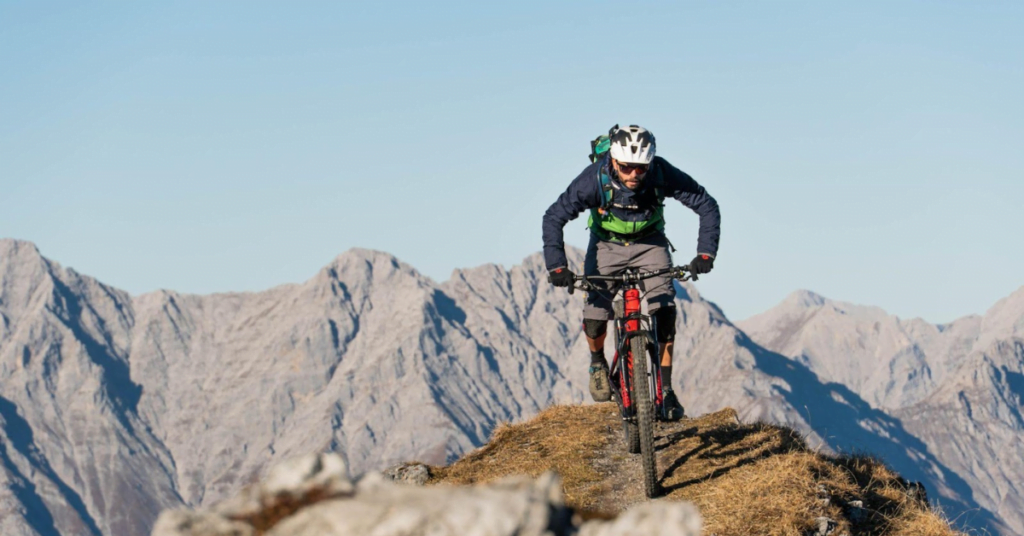Mountain biking has emerged as one of the most exhilarating and rapidly growing outdoor activities. The thrill of navigating rugged terrain, conquering challenging trails, and communing with nature has captured the hearts of adventure seekers and outdoor enthusiasts worldwide. If you’re new to the world of MTB, you’re in for an exciting journey that promises both physical fitness and a deep connection with the great outdoors. So, let’s dive in and discover the world of mountain biking together.
Choosing the Right Bike and MTB Gear
Mountain biking begins with selecting the right bike to match your riding style and preferences. Here’s what you need to consider:
- Hardtail vs. full-suspension: Opt for a hardtail bike if you’ll mostly ride smoother trails and value efficiency. Choose a full-suspension bike for rougher, technical terrain to enjoy added comfort and control.
- Cross-country, trail, and downhill bikes: Cross-country bikes are built for endurance and speed, trail bikes are versatile for various terrains, and downhill bikes excel in steep descents.
- Frame size: The right frame size ensures comfort and control. Consult with a professional or use sizing charts provided by manufacturers to find your ideal size.
- Standover height: Ensure there’s enough clearance between the top tube and your inseam to prevent accidents.
- Handlebar width and stem length: Adjustments to these components can affect your riding position and control.
Before you hit the trails, you’ll also need to gear up properly:
- Mountain bike helmet: Invest in a certified full-face MTB helmet to protect your head in case of a fall.
- Gloves: They provide grip and protection for your hands.
- Pads and armor: Depending on your riding style, consider knee and elbow pads, as well as body armor for additional protection.
- Moisture-wicking clothing: Wear breathable clothing that wicks away sweat to keep you comfortable during rides.
- Cycling shorts: Padded shorts can enhance comfort, especially on longer rides.
- Appropriate footwear: Choose flat or clipless pedals, depending on your preference, and wear comfortable, sturdy shoes.
Basic Riding Techniques: Building the Foundation for Your MTB Skills
To truly enjoy the exhilaration of mountain biking, it’s crucial to grasp the fundamental riding techniques. They serve as the building blocks for your journey into the world of off-road cycling, ensuring you ride safely and confidently through varied terrain.
Body Positioning and Balance
When riding your mountain bike, strive for a balanced and centered posture. Keep your weight distributed evenly over both wheels, with knees and elbows slightly bent. This “neutral” position is your foundation for control and stability.
Depending on the situation, you’ll need to shift your weight strategically. For climbing steep inclines, move your weight forward to maintain traction on the front wheel. Conversely, for descents and technical sections, shift your weight rearward to prevent the front wheel from lifting.
Shifting Gears Effectively
Your bike’s gears are your allies in tackling various terrains. Learn when to shift to maintain an efficient cadence. Lower gears make pedaling easier, ideal for climbs, while higher gears offer more speed and power for flat or downhill sections.
Mastering Braking Techniques
The key to effective braking is modulation—gradually squeezing the brake levers rather than grabbing them. This prevents skidding, maintains control, and minimizes wear on brake pads.
Additionally, you’ll need to understand the role of both front and rear brakes. The front brake provides the majority of stopping power, while the rear brake aids in stability. Practice using them in harmony to maintain control.
Climbing and Descending Tips
When conquering climbs, choose an appropriate gear before ascending, keep your weight forward to maintain traction on the front wheel, and pedal with a smooth, consistent cadence.
When descending, maintain a balanced and relaxed posture. Keep your weight low and centered over the bike, and shift your weight rearward to prevent going over the handlebars on steep descents. Use both brakes judiciously to control your speed.
Handling Obstacles on the Trail
Trails often present obstacles like roots and rocks. Approach them with a slightly lifted front wheel and a bent elbow and knee. As you roll over the obstacle, use your arms and legs to absorb the impact and maintain control.
To handle technical descents with finesse, keep your weight low and centered, with your rear hovering above the saddle. Shift your weight back to navigate steep sections while applying the rear brake to control your speed. Look ahead to anticipate and respond to obstacles.
Trail Etiquette and Safety: Navigating Trails Responsibly
Ensuring a safe and enjoyable experience for yourself and fellow trail users is paramount when engaging in mountain biking. Adhering to trail etiquette and safety guidelines not only preserves the environment but also fosters a positive experience for all.
Sharing the Trail with Others
When on the trail, remember that you’re often sharing it with other outdoor enthusiasts. Whether they’re hikers, runners, or horseback riders, practicing courtesy is essential:
- Prioritize pedestrians and equestrians. Yield the trail to pedestrians and equestrians. Slow down, communicate your presence, and provide plenty of space as you pass.
- Mind your speed. Adjust your speed to match the conditions and the visibility ahead. Be ready to slow down or stop if you encounter others on the trail.
- Announce your presence. Use your voice or a bell to signal your approach when overtaking others. This allows them to step aside safely.
Understanding Trail Markings and Signage
Respecting trail rules and guidelines is crucial to maintain a safe and sustainable riding environment:
- Follow posted signs. Observe and adhere to all posted signs and trail rules. Respect any closures or restrictions in place for safety or conservation purposes.
- Stay on designated trails. Avoid creating new paths or widening existing ones. Stick to established trails to minimize the impact on the environment.
Emergency Preparedness and Communication
Always be prepared for the unexpected and maintain communication channels:
- Carry a cell phone. Have a fully charged phone with you in case of emergencies. Ensure it’s in a waterproof case or pouch to protect it from trail conditions.
- First aid kit. Pack a basic medical kit that includes essentials like bandages, antiseptic wipes, and any personal medications you may need.
Tips for Planning Your First MTB Ride
Embarking on your first mountain biking adventure can be an exhilarating experience. Plan your ride ahead to ensure a safe and enjoyable inaugural MTB journey:
- Research local trails. Look for beginner-friendly options with well-marked routes. Consider factors like trail length, elevation gain, and difficulty ratings.
- Check trail conditions. Recent rain or trail maintenance can affect rideability. Pay attention to any trail closures or alerts issued by local authorities or trail organizations.
- Gear up. Ensure you have the appropriate MTB gear, including a well-fitted helmet, gloves, and comfortable clothing. Don’t forget to pack essentials like water, a multitool, spare tubes, and a tire pump.
- Buddy up or share your plans. If possible, ride with an experienced friend or group, especially for your first ride. They can provide guidance and assistance. If you are cycling alone, share your ride plans with someone, including your estimated return time and the trail you’ll be on.
- Learn basic repairs. Familiarize yourself with basic bike repairs, like fixing a flat tire and adjusting your brakes and gears.
- Hydrate and snack. Bring sufficient water to stay hydrated during your ride, and pack energy-rich snacks like trail mix, energy bars, or bananas to keep your energy levels up.
- Safety first. Always wear your helmet, and make sure it’s securely fastened. Carry a fully charged phone and emergency contact information.
Ultimately, just have fun. It’s natural to encounter challenges on your first ride. Be patient with yourself and enjoy the learning process, focusing on the positive and relishing the unique experiences that mountain biking offers.

In conclusion
Embarking on the exhilarating journey of mountain biking as a beginner opens the door to a world of adventure and personal growth. Remember to choose your equipment wisely, develop your skills gradually, uphold trail etiquette, and prioritize safety. As you set out on this thrilling pursuit, it’s essential to embrace the joy of progression and challenge, knowing that every trail you conquer, and obstacle you overcome brings you closer to mastering the sport.
So, with a helmet securely fastened and a heart full of excitement, step onto the trails and enjoy all the incredible experiences you can find when mountain biking.






